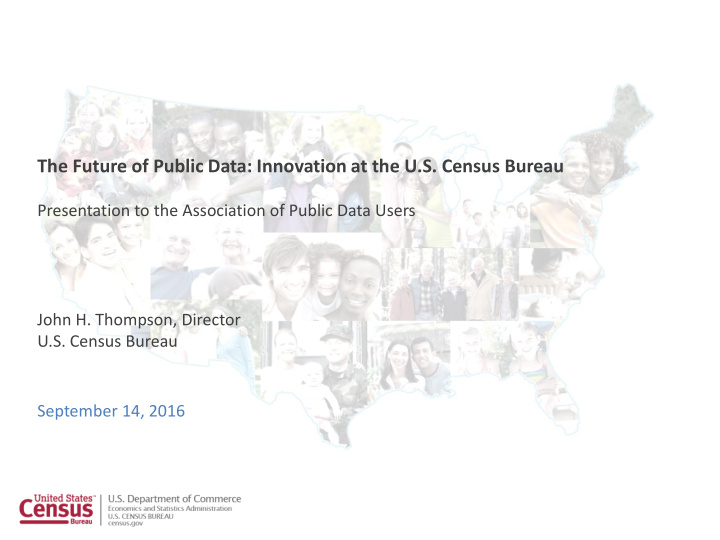



The Future of Public Data: Innovation at the U.S. Census Bureau Presentation to the Association of Public Data Users John H. Thompson, Director U.S. Census Bureau September 14, 2016
The 2020 Census A Changing Environment and a New Design Constrained fiscal environment Rapidly Mobile changing use population of technology The 2020 Census requires a flexible design that takes advantages of new Informal, 2020 Census Information technologies and data complex living explosion arrangements sources, while minimizing risk to ensure a high quality population count. Increasingly Distrust in diverse government population Declining response rates 2
The 2020 Census Goals and Key Innovation Areas Goal: To count everyone once, only once, and in the right place Challenge: Conduct the 2020 Census at a lower cost per housing unit (adjusted for inflation) than the 2010 Census, while maintaining high quality results Four Key Innovation Areas Utilizing Reengineering Optimizing Administrative Reengineering Field Address Canvassing Self-Response Records and Third- Operations Party Data 3
The 2020 Census Estimated Lifecycle Costs 4
Adaptive Design Making Data Collection Faster, Better and Cheaper National Survey of College Graduates Adaptive treatments produced significantly better Information on costs results in improving survey representativeness, without affecting response rates compared to + experimental control groups Fieldwork quality + Survey of Income and Program Participation and Estimates of key variables National Health Interview Survey Case prioritization through adaptive treatments helps survey directors make informed cost/quality trade-off decisions during data collection operations Modified and improved data collection efforts Concurrent Analysis & Estimation System Big Data distributed analytical processing using a Hadoop cluster, leading the way for high volume/high speed computer processing for real- time adaptive interventions 5
Administrative Records Improving Data Collection and Dissemination • Frame Before data • Predict (i.e. mode, best time to contact) • Contact collection During data • Edit • Impute collection • Replace After data • Evaluate • Model release • Innovate 6
Disclosure Avoidance Disseminating Data While Honoring Privacy & Confidentiality Confidential Information U.S.C. Title 13 U.S.C. Title 26 Protection & Statistical promises confidentiality to mandates that statistical Efficiency Act respondents; collected products are subject to provides confidentiality data is used for statistical disclosure avoidance protections for statistical purposes only procedures information collections Center for Disclosure Avoidance Research areas of study: Provably private disclosure limitation methods for the 2020 Census Synthetic data disclosure limitation methods for the American Community Survey Synthetic data with validation for the 2017 Economic Census 7
Improving Economic Statistics Meeting User Demands for Timelier, More Granular, Linkable Data Retail trade is our first focus: 8
Center for Enterprise Dissemination Services and Consumer Innovation Shared, Reusable Systems for Dissemination 9
CitySDK Toolbox for Developers and Civic Innovators to Connect to Local & National Public Data
Opportunity Project Development Initiative to Increase Access to Fair Housing Collaboration between the U.S. Department of Housing and Urban Development, the White House, the Census Bureau, and cities and local goverments Helps cities and local governments use new, curated, open data to account for how they use federal housing dollars, and increase access to fair housing
Census Business Builder Small Business and Regional Analyst Editions
Center for Big Data Research and Applications Innovation Measurement Initiative Project from the Census Bureau, U. Michigan, and U. Chicago that links R&D and innovation by integrating data on federally-funded university grants with Census Bureau data assets
Future On Embracing Transformation Internally
Thank you!
Recommend
More recommend